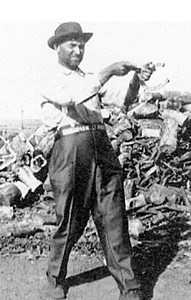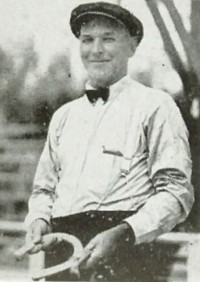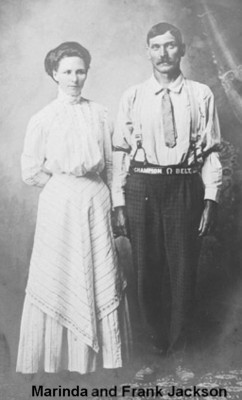|
FRANK ELROY JACKSON, KELLERTON, IOWA
 Frank Elroy JACKSON, born October 9, 1870 in Kansas, the son of Andrew and Miranda JACKSON. Frank was a farmer residing near Kellerton, Ringgold County, Iowa. He was just a month or so away from
his 39th birthday when he entered into the first World Championship Horseshoe Pitching Tournament.
there was nothing fancy about Frank's attire for world tournaments: A battered old felt hat, long-sleeved shirt with a
skinny necktie tucked in near one of the top buttons; unpressed pants held up by suspenders.
Frank Elroy JACKSON, born October 9, 1870 in Kansas, the son of Andrew and Miranda JACKSON. Frank was a farmer residing near Kellerton, Ringgold County, Iowa. He was just a month or so away from
his 39th birthday when he entered into the first World Championship Horseshoe Pitching Tournament.
there was nothing fancy about Frank's attire for world tournaments: A battered old felt hat, long-sleeved shirt with a
skinny necktie tucked in near one of the top buttons; unpressed pants held up by suspenders.
The first horseshoe pitching tournament in which competition was open to the World was held in the summer of 1910 in
Bronson, Kansas. The winner out of 34 contestants was Frank JACKSON. He was awarded a World Championship belt with horseshoes attached to it. At
this time, JACKSON had never heard of being able to hold a shoe so it would open toward the stake, but he had been
practicing to find some way by holding his shoe with his finger around the heel calk so he could pitch ringers. The games
were played on dirt courts on stakes 2 inches high above the level ground with stakes 38 feet apart. JACKSON had acquired
the skill of pitching a ringer over the 2-inch stake and laying his second shoe on top of the stake time after time so his
opponent couldn't keep his ringer on. Each man drew a number in this tournament and Number 1 played Number 2, Number 3
played Number 4, and so continued until every man had played. Then numbers were drawn again by the winners, and play
continued in the same way until the last winner was declared the World Champion. Game points were 21, ringers counted
five, leaners three, and close shoes one. There was no regulation shoe size or weight. In 1911, the height of the stake
was raised to six inches with the same scoring system with closest shoe counting one regardless of the distance form the
stake. The top ringer received the count of all ringers on the stake. Games were still 21 points. One pitcher had a shoe
in which the curve on one side was four inches more than on the other side. At a Topeka Tournament, JACKSON used a pair
of shoes he had made by a blacksmith, who bent the calks so the shoe would slide better in the sand and help him slide
ringers on the stake.
Rochester, Minnesota, 1926 ROCHESTER QUOIT PITCHERS BEAT AUSTIN, JACKSON HERE
Several Hundred Spectators Gather to See Championship in Action
Hammond Man Gives Younger JACKSON Best Workout of Exhibition

 By a score of 219 points and 66 ringers over their opponents, Rochester horseshoe pitchers won from Austin in a 36 game
meet yesterday morning in Mayo Park.
By a score of 219 points and 66 ringers over their opponents, Rochester horseshoe pitchers won from Austin in a 36 game
meet yesterday morning in Mayo Park.
In the afternoon more than 700 gathered to see such pitching of horseshoes as they had ever seen before when Frank E.
JACKSON, national champion, and his son, Vyrl, appeared in a match, throwing double after double and always at least one
ringer. Rain clouds gathered shortly before the afternoon tournament, but the shower stopped in time for the match.
Charlie BEYER of Hammond, gave the younger JACKSON the best competition of any local players with a score of 30 points
and 27 ringers against his 50 points and 33 ringers.
No one could touch the senior JACKSON. Sun browned and wearing an old slough hat, brown trousers held up by good
old-fashioned suspenders, JACKSON senior, pitched his shoes with perfect ease, while he kidded the crowd between plays.
No one could hold a candle to him except his son. The two played two games together. The scoring was as follows: JACKSON
senior, 52 points, 42 ringers, 17 doubles; JACKSON junior, 28 points, 34 ringers, 9 doubles; the second game, JACKSON
senior, 51 points, 39 ringers, 13 doubles; JACKSON junior, 39 points, 34 ringers, 7 doubles.
The first event in the tournament was a double match between Frank JACKSON and Bill HAVENOR vs. Vyrl JACKSON and Otto HANKE.
The ringers were as follows; JACKSON senior, 51 points, 23 ringers, 9 doubles: HAVENOR, 8 points, 9 ringers and 3 doubles;
JACKSON junior, 54 points,22 ringers, 5 points; HANKE, 11 points, 10 ringers.
Results of the game between JACKSON senior and Herman BEYER of Hammond was JACKSON, 50 points, 28 ringers, 9 doubles;
BEYER, 4 points, 12 ringers, 2 doubles.
Following the games, the JACKSONs presented fancy pitching. This included throwing shoes through a hoop and making doubles
on the stake, throwing the shoes over pop bottles close to the stake without breaking the bottles, and pitching at four
stakes and putting the shoe on one desired.
In the match with Austin, the local players were HAVENOR, KANKE, W. MUNDT, Wm. GORDY, Henry SCHEFELBINE, and H. BADGER.
The Austin players were Max MILLER, Pete PETERSON, Tom DeMOSS, James Miller, J. E. MOONEY and Ed CONLIN.
Frank JACKSON, of Kellerton, Iowa, held the following titles:
 1909, World Championship
1909, World Championship
1910, World Championship
1911, World Championship
1912, World Championship
1913, World Championship
1915, World Championship
1920, World Championship
1921, World Championship
1924, World Championship
1925, 2nd in World Championship
1926, World Championship
1927, Iowa State Championship
1928, Iowa State Championship
1929, Iowa State Championship
1930, Iowa State Championship
1932, Iowa State Championship
 Frank served on the Horseshoe Pitching Rules Committe for several years.
Frank served on the Horseshoe Pitching Rules Committe for several years.
In 1924, Frank and his sons Hansford and Carroll put on an exhibition match at the World Tournament held in Minnesota.
There wasn't much money in exhibitions during the Great Depression and Frank went broke from trying to farm. His last
World Tournament was in 1935 at Moline, Illinois, where he, at age 65, finished fifth with a 72.9% ringer average. Frank
barnstormed all over the county until 1940. He later operated a motel in Florida and died on December 27, 1955, Tampa,
Florida, at the age of 85. He was married to Marinda SHELDEN, born in Iowa on January 16, 1879, the daughter of Truman Chapin SHELDEN (1830-1886) and Lydia Melvina (GOFF) SHELDEN (1841-1925). She died in 1949, Florida. Frank and Marinda
were interred at Orange Hill Cemetery, Tampa, Hillsborough County, Florida.
Interestingly, Frank won four world titles before winning an Iowa State title. This was because Iowa did not hold a
statewide tournament until after 1920, with a singles tournament introduced in 1921.
Frank JACKSON was inducted into the Horseshoe Pitching Hall of Fame in 1966, currently ranking 4th on the all-time
horseshoe world championship list.
In 1971, Frank JACKSON was inducted into the Des Moines Register's Iowa Sports Hall of Fame. In the April 11, 1971
edition of the Register, it was noted, "JACKSON was the most durable champion Iowa has had in any sport." With
great respect, Otto W. RENO wrote, "JACKSON was the father of horseshoes."
SOURCES:
en.wikipedia.org/wiki/Horseshoes
www.horseshoepitching.com "Facts and Folklore"
FETTY, Jack. Rings of Gold Pp. 50-52. Palindrome Pub. Co. Iowa. 2007.
Transciption by Sharon R. Becker


|